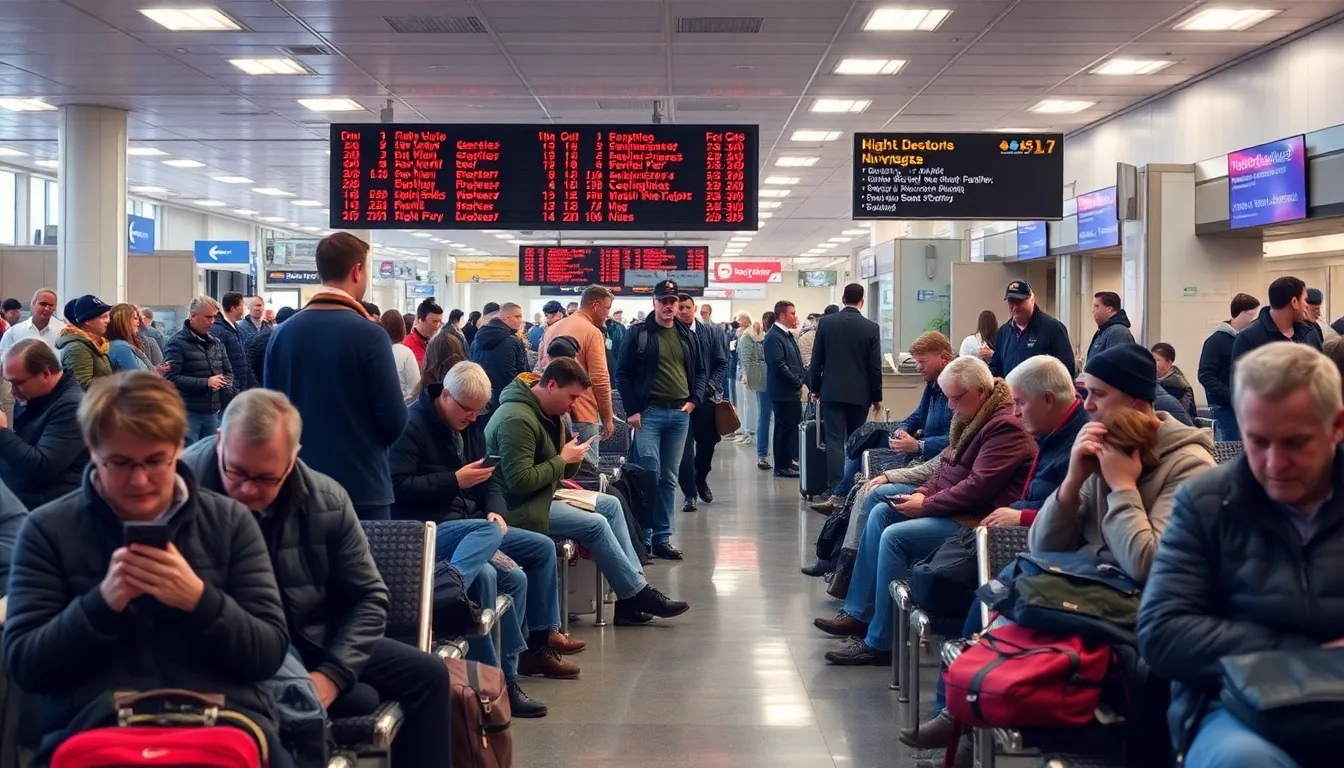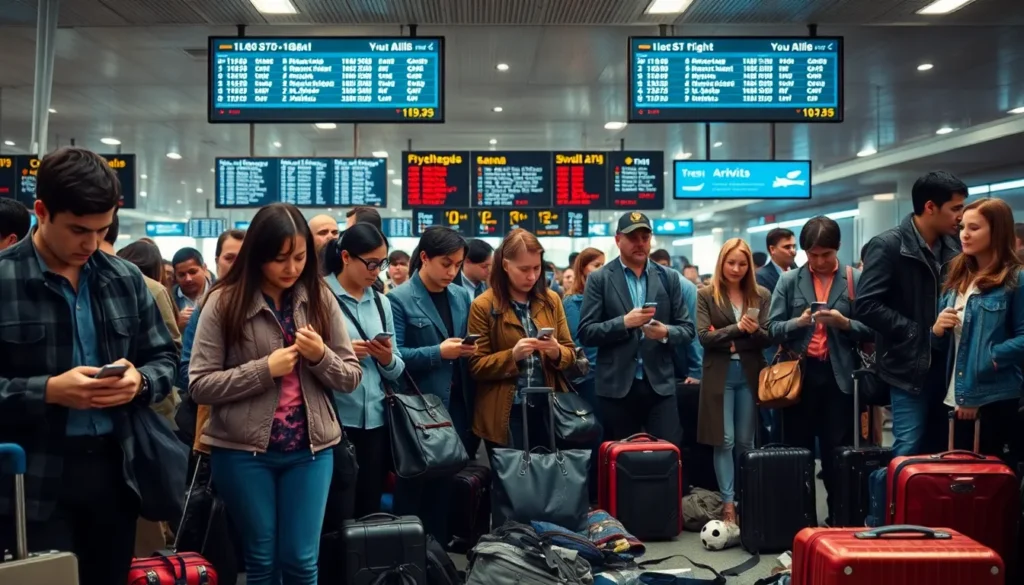Table of Contents
ToggleIn the world of air travel, timing is everything. Imagine planning your trip down to the last detail only to find yourself in a heated battle over departure times. Welcome to the saga of flight SD1555958A, where delays and scheduling mishaps turn into an unexpected comedy of errors.
Departure Time Fight SD1555958A Overview
Flight SD1555958A exemplifies the complexities of modern air travel. Passengers encountered unexpected delays that affected their itineraries. Initial departure was scheduled for 3:00 PM, but weather conditions prompted a reschedule. Limited communication from airline staff compounded frustrations.
Delays extended another hour as updates remained sporadic. Travelers experienced a mix of anxiety and confusion during this time. Frequent announcements from the gate were crucial for maintaining passenger awareness.
Airline protocols require timely notification, but inconsistencies plagued this specific flight. Other flights proceeded smoothly, highlighting the disparity in operational efficiency. Real-time tracking tools provided some relief, allowing passengers access to updated information.
Conversations among travelers revealed shared experiences of frustration. Many expressed the need for better contingency plans during severe weather events. Quick access to reliable updates emerged as a key theme, addressing passenger concerns for future flights.
Flight SD1555958A serves as a case study on air travel dynamics. It illustrates the impact of timing and communication on the travel experience. Embracing improvements in real-time information sharing could enhance passenger satisfaction moving forward.
Background Information

Flight SD1555958A highlights the complexities faced by travelers in modern air travel. Delays, scheduling issues, and communication breakdowns often create challenges for passengers.
History of the Flight
Flight SD1555958A has an eventful history characterized by unexpected developments. Initially slated for departure at 3:00 PM, it encountered severe weather that prompted its rescheduling. Multiple updates indicated shifting timeframes, but passengers experienced a lack of clarity. On the day of travel, delays accumulated, leading to a departure time that extended well beyond the original schedule. Previous incidents involving the flight had also raised concerns about punctuality, which may have contributed to growing frustrations among travelers.
Key Participants
Passengers, airline staff, and airport personnel played vital roles during the events surrounding flight SD1555958A. Travelers expressed their discontent through conversations as they awaited further announcements. Airline staff faced the challenge of managing a difficult situation, striving to provide information despite the unpredictable circumstances. Meanwhile, airport personnel worked diligently to ensure safety protocols remained intact. Support from fellow passengers created a sense of community, as they navigated shared anxieties tied to the unfolding events. Communication from all parties will remain crucial in managing future travel disruptions effectively.
Analysis of Departure Time
Departure time holds significant weight in the context of air travel dynamics, directly impacting the overall travel experience. Flight SD1555958A exemplifies how critical timely departures can be for managing passenger expectations and schedules.
Importance of Departure Time in Combat
Departure time represents a crucial element in combat scenarios. Understanding precision in time management often dictates mission success or failure. Timing assures that forces or resources arrive as planned, allowing for coordinated efforts. Delays can jeopardize operations, cause personnel anxiety, and disrupt strategic plans. Military exercises often stress punctuality to enhance readiness. Optimal deployment relies on delivering units according to schedule, ensuring effectiveness during operations. Communication with ground control remains vital, enhancing coordination during aerial missions.
Factors Influencing Departure Time
Several factors play a role in determining departure time. Weather conditions frequently affect flight schedules, with severe weather requiring adjustments. Equipment readiness also influences timing, as mechanical issues can delay departures. Additionally, air traffic control procedures dictate flight paths, influencing departure sequences. Passenger boarding efficiency contributes to timely departures, as slow processes can hold up flights. Airline protocol varying among carriers further complicates adherence to scheduled times. Lastly, unexpected events such as emergencies or security threats can drastically alter planned departure times.
Implications of the Fight Results
Fight results from SD1555958A can significantly influence future matchups and the trajectories of fighters’ careers.
Effects on Future Matches
These outcomes shape matchmaking decisions. With this fight’s results exhibiting fighters’ strengths and weaknesses, promoters analyze performance closely. Performance metrics can dictate contenders’ rankings, determining eligibility for title shots. Familiarity with the fighters creates interest among fans, driving engagement for future events. Enhanced anticipation arises when fighters display exceptional skills or resilience during the bout. Additionally, injuries sustained may affect availability for upcoming fights, altering the competitive landscape.
Impact on Fighter Careers
Career trajectories transform drastically due to fight results. Winning a match often elevates a fighter’s status and marketability, resulting in increased sponsorship opportunities. Conversely, losses can require significant adjustments, such as regime changes or style modifications. Relationships with trainers and managers may strengthen or deteriorate based on performance. Fighters can also gauge their skills against tough opponents, offering valuable insights for improvement. Thus, the implications of this fight resonate through rankings, opportunities, and reputational standing within the sport.
Flight SD1555958A serves as a compelling example of the unpredictability inherent in air travel. The challenges faced by passengers highlight the need for better communication and real-time tracking tools. As travelers navigate delays and frustrations, the importance of timely departures becomes increasingly clear.
The implications of this flight extend beyond immediate inconveniences. They shed light on the broader dynamics of air travel and the interconnectedness of various factors that dictate a successful journey. By addressing these challenges head-on, airlines can enhance the overall travel experience and foster greater passenger satisfaction in the future.




